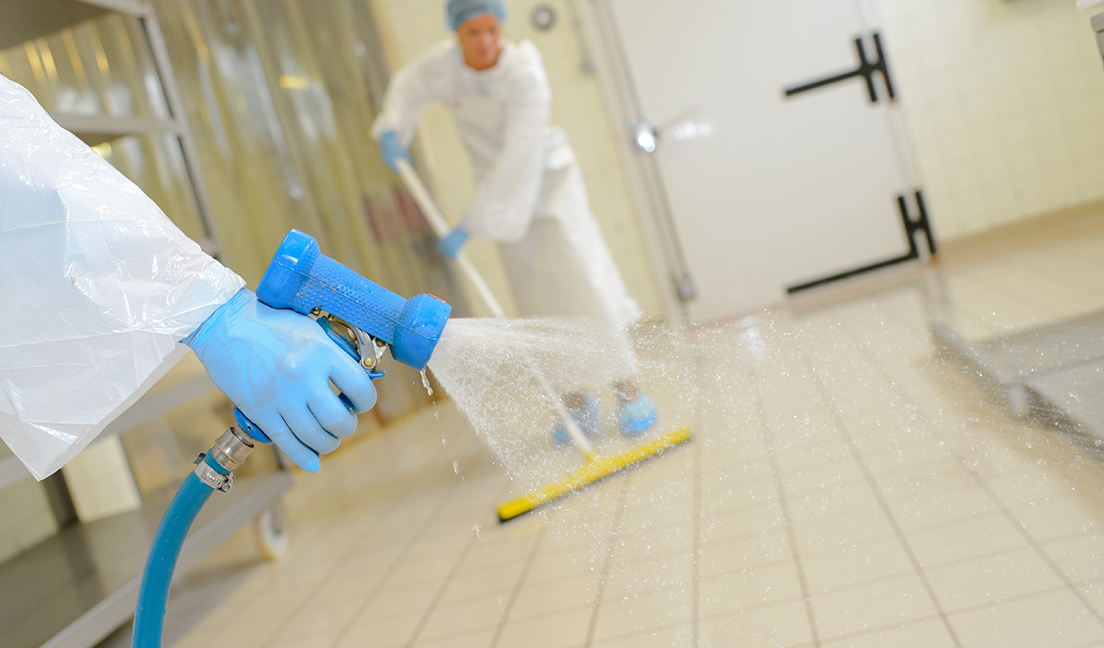Microbiological contamination in food and beverage production, be it bacteriological by Pseudomonas, Listeria, Salmonella or by several other pathogens, can lead to product recalls, plant shut down and, the worst: loss of reputation. When microorganisms’ are detected anywhere in the factory operators reach for the bleach; sodium hypochlorite, which is the most widely used disinfectant in the food industry. Hypochlorite is an oxidizing biocide that is readily available and well understood, however, its intensive usage has led to concerns that some pathogenic bacteria, such as Aeromonas and Bacillus cereus are showing signs of resistancei. Alternative chemicals such as peracetic acid are available, but most are less easy to handle than hypochlorite and may raise health and safety risks. There is one sustainable alternative that has been around for many years but, until recently, has been little used in the food and beverage sectors: ozone.
Food and beverage facilities typically use chlorinated water not only for automatic cleaning in place (CIP) procedures but also for manually washing down working surfaces, conveyors and other items of equipment which are not covered by CIP. Ozone has proved a superior and faster acting disinfectant in both applications. Ozone dissolves in water forming a free hydroxyl radical which is a very powerful antimicrobial agent. Produced from oxygen by a high frequency silent electrical discharge, ozone has been used for the disinfection of drinking water for over a hundred years. Ozone isn’t new to the food processing industry either. Back in 1999, a study by Kim et ali[i] showed the effect of dissolved ozone in a batch reactor on Listeria monocytogenes. Dissolved ozone at 0.4 and 0.8mg/l inactivated 4.6 and 5.7 log CFU/ml within 30 seconds. A later studyi[ii] demonstrated that higher dissolved ozone concentrations gave faster (immediate) inactivation of the bacterium – much quicker than bleach. Ozone is likewise very effective at removing biofilms by rapidly oxidizing the extracellular polysaccharides that give biofilms their adherent natureiv. A major benefit of ozone for the food industry is that it decomposes rapidly to form oxygen without forming residues and by-products that might cause off-tastes or odours.

Traditional ozone generators are large, fixed items of process plants, easy to integrate into CIP systems but lacking the flexibility needed for supplying washdown water around the factory. Evoqua has a long track record in this type of application, and has just introduced a compact, portable “Ozone cart”, the new PC3 disinfection system, that can provide ozonated water instantaneously anywhere in the food processing factory simply by connecting it to a convenient water supply. The complete stainless steel skid mounted disinfection system incorporates an onboard oil free air compressor which delivers air to an oxygen concentrator and passes it through an air-cooled ozone reactor with a controlled output. The ozone gas is then injected and dissolved into the flow of water delivered by an integrated booster pump to a connected hose and nozzle system. It also includes an off-gas destructor to ensure that no ozone gas is discharged into the workplace.
Recently, there was an incident involving Listeria at a large seafood processing facility in Europe. Normal disinfectants had failed to inactivate the bacteria and in urgent need of a solution, they called Evoqua who managed to deliver a PC3 disinfection system in a couple of weeks. The new mobile ozone system was used to wash down tanks, vessels, work surfaces, conveyors and other equipment that were difficult to access. After the introduction of ozone no Listeria has been detected. Sanitisation by ozone has made the products safer, enhanced the shelf-life of fresh produce and protected the company’s brand, it has also proven to be more economical than the chemicals that were previously used. Employees also gained a safer working environment as the ozone supported the destruction of slippery biofilm from the floor, and they noticed reduced smells in the factory.
This experience is supported by studies undertaken by the Norwegian Institute of Water Research (NIVA)v. They grew biofilms of Listeria monocytogenes on plastic and steel surfaces in the laboratory. The surfaces were then exposed to ozonated water, either by immersion or by flushing. After treatment with ozonated water, no viable bacteria were found.
These and other studies suggest that ozonated water is very effective at destroying most bacteria and viruses. In short, ozone is an excellent alternative to sodium hypochlorite, especially where there is evidence of bacterial resistance, and can be easily applied to equipment and work surfaces in all food and beverage sectors from vegetable and salad packaging to biscuit baking, food processing, brewing and soft drinks production.
[i] Ding W, Jin W, Cao S, et al. Ozone disinfection of chlorine-resistant bacteria in drinking water. Water Research. 2019 Sep;160:339-349. DOI: 10.1016/j.watres.2019.05.014.ii Kim JG et al Application of ozone for enhancing the microbiological safety and quality of foods: a review J Food Prod. 1999 Sep; 62(9):1071-87.
[ii]i Kim JG, Yousef AE.. Inactivation kinetics of foodborne spoilage and pathogenic bacteria by ozone. J Food Sci 2000 65:521-528.iv Mariko Tachikawa, Kenzo Yamanaka & Katsuhiko Nakamuro (2009) Studies on the Disinfection and Removal of Biofilms by Ozone Water Using an Artificial Microbial Biofilm System, Ozone: Science & Engineering, 31:1, 3-9, DOI: 10.1080/01919510802586566v Helge Liltved, Halvor Hektoen, Harry Efraimsen, Inactivation of bacterial and viral fish pathogens by ozonation or UV irradiation in water of different salinity, Aquacultural Engineering, Volume 14, Issue 2,1995, Pages 107-122
